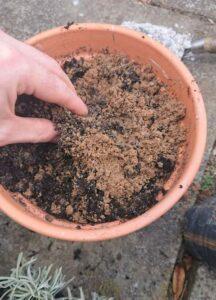Thyme, a beloved herb from the Mediterranean, is cherished for its aromatic leaves and culinary versatility. But if you’ve noticed your thyme plant turning brown, it’s crucial to address the issue promptly. In this article, we will explore the common causes of browning thyme plants and provide solutions to help revive them.
The Culprit: Excess Moisture and Fungal Disease
One of the primary reasons thyme plants turn brown is due to fungal diseases caused by excess moisture around the roots. Thyme, native to the Mediterranean region, thrives in somewhat dry conditions. Overwatering and slow-draining soils create the perfect environment for fungal pathogens to thrive, leading to browning thyme plants.
Age can also contribute to the browning of thyme plants. Like many Mediterranean herbs, thyme has a relatively short lifespan and may naturally turn brown and die after four years, even with proper care. However, it is worth noting that water scarcity is not a typical cause of thyme turning brown, as thyme is drought-resistant and tends to wilt rather than brown due to dehydration.
Identifying the Causes of Browning Thyme
To understand why your thyme plant is turning brown, consider the following factors:
Thyme Turning Brown due to Moist Soil
Thyme plants originate in the arid Mediterranean region, where they thrive in full sun, sandy well-draining soils with infrequent rainfall. When thyme plants are subjected to overwatering or cold, wet soils, they can turn brown, especially during winter.
Three main reasons contribute to thyme turning brown due to excess moisture around the roots:
- Overwatering: Thyme is a drought-resistant herb adapted to arid conditions. If you water your thyme before the soil has a chance to dry out somewhat, you may be overwatering, leading to browning.
- Slow-draining soils: Thyme plants flourish in porous, well-draining soil resembling Mediterranean sandy conditions. Ensure your soil replicates these conditions to prevent waterlogging and root rot.
- Pots without drainage holes: Planting thyme in pots lacking proper drainage can trap excess water, leading to soil saturation and browning. Always opt for pots with drainage holes to promote healthy root growth.
Saving Browning Thyme Due to Moist Soil
Reviving a thyme plant turning brown due to excess moisture requires taking specific steps:
- Scale back watering: Thyme prefers drying out somewhat between waterings. Water only when the soil feels dry to a fingers’ depth. Adjust your watering frequency according to climate and conditions to prevent soil from staying consistently moist.
- Transplant thyme: If your thyme is planted in slow-draining or waterlogged soil, consider transplanting it to a pot. Use a well-draining potting mix with some horticultural sand or grit to improve soil drainage.
- Ensure proper drainage: Opt for pots with drainage holes and a size that accommodates thyme’s growth. Clay or terracotta pots are excellent choices, offering better moisture regulation than plastic or metal containers.
While transplanting, carefully inspect the roots. If you notice any brown, soft, or rotten roots, remove the infected sections. Use sterile pruners and wipe the blades with alcohol disinfectant after each cut to prevent the spread of fungus. Disposing of infected plant material and potting soil is crucial to eliminate the source of fungal pathogens.
Replant your thyme in new soil, combining multipurpose compost with sand or grit for improved drainage. Shelter the plant from excessive rainfall if possible, placing it in full sun. After two weeks, water generously at the roots, allowing excess water to drain from the pot’s base. Additionally, if your thyme plants are in garden borders, treat the soil with organic fungicide to prevent reinfection.
By implementing these steps, you can give your thyme plant the best chance of recovery. Keep in mind that severely infected and largely brown plants may be challenging to revive. Consider growing thyme in pots, containers, or raised beds to avoid water stress and maintain the plant’s health.
High Humidity and Browning Leaves
Thyme thrives in arid climates with low humidity. Planting thyme too closely together can create a humid microclimate, leading to the development of diseases like Alternaria blight. This fungal disease primarily affects the lower leaves, causing brown spots.
To prevent humidity-related browning:
- Plant thyme 2-3 feet apart: Give each thyme plant enough space to allow for proper airflow, reducing the risk of disease.
- Consider potting: Growing thyme in pots increases airflow and keeps plants free from disease.
Thyme Turning Brown Due to Age
Thyme is a perennial plant that can live for a few years and withstand frost during winter (hardy to USDA zone 5). However, after around four to five years, thyme plants may begin to turn brown naturally. As the plant ages, its leaves lose their flavor and aroma, becoming woody and less productive in terms of quality leaves.
To ensure a continuous supply of thyme for culinary uses, you can propagate new plants from cuttings, replacing older ones.
Conclusion
If your thyme plant is turning brown, excess moisture and fungal diseases are likely culprits. By addressing issues such as overwatering, slow-draining soils, and inadequate drainage, you can save your thyme plant from further browning. Emulating the plant’s preferred Mediterranean conditions, including proper spacing and potting, also helps prevent diseases caused by high humidity. Remember that thyme plants have a limited lifespan, and replacing older plants with new ones is a cost-effective solution to ensure a steady supply of flavorful leaves.
By understanding the causes of browning thyme plants and implementing appropriate remedies, you can enjoy healthy, thriving thyme in your garden or kitchen.


